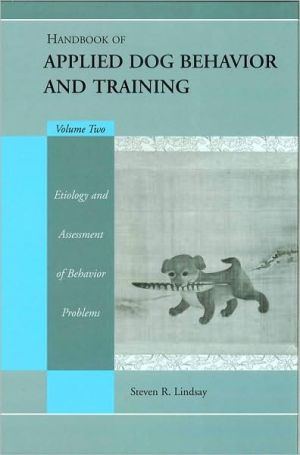

 |

|

The average rating for Handbook of Applied Dog Behavior and Training, Etiology and Assessment of Behavior Problems based on 2 reviews is 3.5 stars.
Review # 1 was written on 2020-12-11 00:00:00 Sheila Cook Sheila CookSo-so. This book contains a lot of information, not much of which is practical for the average dog owner looking for advice regarding behavioral challenges, and much of which is passé and no longer relevant in the world of modern behavior modification training. However, as an educational resource for those interested in the fields of ethology and ABA / behavioral modification, it provides a slew of cited research, history, and analyses regarding aggression and other behavioral issues in dogs. (Unfortunatley, even these are only partially useful as they include some outdated views regarding pack structure and dominance, as well as conflicting and confusing information that appears to both refute and support these ideas at various points within the book.) With that said, I really appreciated learning the history of behavioral issues and how they were addressed through various points in time, which I found very intersting, along with the author's support of the modern trending away from punitive techniques via the LIMA (least intrusive minimally aversive) approach- however, readers should be aware that the use of aversives here isn't entirely discounted. Ultimately I had a few areas of contention with the book- the first being the notion of genetics as a primary cause of aggression, and the second being the issue of "dominance aggression". Granted, this book is approaching 20 years old, and the scientific understanding of genetics has changed a LOT over that span. We now know that genetic predisposition is not equal to genetic expression, and this brings us into the burgeoning field of epigenetics. For a dog's aggression to be purely genetic, the behavior would have had to have been present from birth, much the same as coat or eye color. The term "Genetic predisposition" makes much more sense in that it implies a genetic susceptibility which also requires a triggering factor or event in order for it to manifest (in other words, epigenetics). If a dog has a genetic predisposition towards aggression, but no traumatic history and plenty of positive social experiences, structure, and training, it may never display aggressive behavior at all; whereas if it later developed aggression despite these precautions, then you would have to look elsewhere for epigenetic triggers, such as diet (which amazingly is touched on in the book!), disease (in particular thyroid or neurological disorders), injury (such as traumatic brain injury/neuro-inflammation), and chemical toxicities (including vaccine injury). On a personal note- the fact that so many instances of sudden-onset aggression in dogs which have been well socialized seem to occur at adolescence, and largely around the time of routinely administered puppy vaccines, really makes me lean heavily on the latter being a major epigenetic trigger in bringing about agression in dogs which are genetically predisposed. On the subject of "dominance aggression", readers should be aware that the very existence of dominance and dominance-related aggression is hotly contested among trainers and behaviorists, many of whom agree that fear-based aggression can be displayed in an assertive/defensive manner that is often misidentified as "dominance" yet has nothing to do with rank or social structure. The implications of this in light of traditional training methods which are often used on dogs labeled with "dominance aggression" is substantial and bears examining. It's my own experience and opinion that fear can be either internalized (withdrawal, cowering, submissiveness) or externalized (forward posture, head and ears up, puckered lips or tight closed mouth, tail and back fur erect (piloerection), staring, lunging, barking, biting, etc), and that true fear agression can fall anywhere on the scale between the two, and therefore be displayed as any combination of the above descriptions. Additional notes of interest for me were the inclusion of neurotic and compulsive behaviors and their potential links to nutritional and gut-flora imbalances, which I found to be ahead of its time though it surprisingly was supported by research and data cited from several decades prior to this book itself. At the end of the day, this is a very detailed and intensive study on the subject of behavior and behavioral modification- NOT a light read, and NOT a DIY book by any means. As an older book, it inevitably contains outdated information which should be taken with a grain of salt, but nevertheless provides a fascinating and insightful look into a very complex topic. |
Review # 2 was written on 2008-02-14 00:00:00 Kok-kiong Loh Kok-kiong LohTextbook. Tedious, but chock full of really great information. |
CAN'T FIND WHAT YOU'RE LOOKING FOR? CLICK HERE!!!